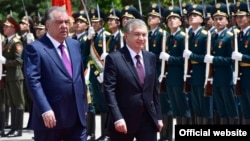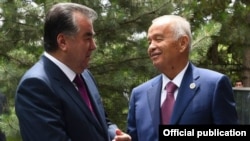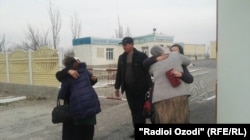The most popular man in Tajikistan has arrived for a three-day visit to that country.
But it's not a Tajik -- it's Uzbek President Shavkat Mirziyoev.
And the reason he is so popular in Tajikistan is because Tajiks see Mirziyoev as a reformer, someone who is loosening state control over society and making positive changes in Uzbekistan -- while his counterpart in Tajikistan, Emomali Rahmon, has been doing the opposite.
Mirziyoev is also reversing many of the policies of his predecessor -- Islam Karimov -- that left relations between the two countries in tatters and often seemed deliberately aimed at punishing Tajikistan.
Mirziyoev started making promises about reforms as soon as he took over as Uzbekistan's leader in September 2016.
Many people in Uzbekistan have trouble seeing a lot of those reforms, but Mirziyoev's comments about greater social, political, and religious freedoms resonate strongly in Tajikistan, where the process has been heading in the opposite direction.
Ahead of what many see as Rahmon's move to install his son, Rustam, as the next president of Tajikistan, authorities have worked to eliminate political rivals and tighten control over the country, including the number of people who practice Islam.
Improving Ties
But while Mirziyoev's credentials for reforms at home might be in question, his work in improving ties with Tajikistan is undeniable.
In the last 21 years, official visits by Uzbek presidents to Tajikistan happened less often than total solar eclipses.
When Mirziyoev visited Tajikistan in March 2018, it was the first time since 2000 that an Uzbek president had done so.
Many of the obstacles to good Tajik-Uzbek relations that Mirziyoev inherited when he succeeded Karimov were removed and his meeting with Rahmon on that trip was characterized by a warmth and spirit of cooperation which had not been seen since the two countries became independent after the collapse of the Soviet Union in 1991.
The cantankerous Karimov, who ruled over Uzbekistan during all the years of independence until his death in 2016, dictated terms to Tajikistan and felt that Uzbekistan's role in the 1992-1997 Tajik Civil War was decisive in keeping Rahmon in power there.
It became clear early on that Uzbekistan had many levers it could use to pressure Tajikistan, starting with access to the outside world.
Tajikistan is backed up into the southeastern corner of Central Asia, hemmed in on the east, and most of the north and south, by the Pamir Mountains.
The easiest way into or out of Tajikistan by land is through the west -- through Uzbekistan.
Tajikistan's civil war broke out in the spring of 1992. In order to keep Tajikistan's problems from spilling into Uzbekistan, in September of that year Karimov ordered the governors of the Uzbek provinces neighboring Tajikistan not to accept any war refugees.
Railway routes connecting the two countries were reduced and eventually almost cut entirely.
The Soviet-era roads connecting the two countries were shut at the border and only a trickle of cargo traffic was allowed to cross.
Some of these roads stayed closed and others that were open regularly had long lines of traffic waiting to cross until Mirziyoev became president.
The 'Karimov Wall'
Walls and fences constructed along parts of the Tajik-Uzbek border also remained standing until Mirziyoev took over.
Just weeks before Mirziyoev's March 2018 visit to Tajikistan, officials and citizens from both countries took part in a ceremony to demolish the so-called "Karimov Wall," which divided part of Tajikistan's Sughd region from Uzbekistan's Samarkand Province.
In early 2016, Uzbekistan completed the $1.9 billion Angren-Pap railway line, built specifically so that trains between eastern Uzbekistan and the Tashkent area would not have to pass through Tajik territory.
Karimov also objected to Tajikistan's plans to build the massive Roghun hydropower plant, and Uzbek authorities halted trains bringing cement and other construction materials to Tajikistan. By early 2010, rail cargo bound for Tajikistan had dropped by some 40 percent.
Then, in late 2011, there was a mysterious explosion at a bridge in Uzbekistan along the Ghalaba-Amuzang railway line that totally suspended shipments along that route.
In January 2013, then-Tajik Agriculture Minister Qasim Qasimov complained that Uzbekistan's closure of railway lines connecting to Tajikistan left his country without its primary means to export agricultural products.
The Ghalaba-Amuzang bridge was finally repaired just before Mirziyoev's March 2018 visit and has been operational since.
Other railway connections have also reopened, and one of the big agreements expected to be signed during Mirziyoev's current visit envisions construction of a new railway line connecting the Uzbek city of Samarkand to the Tajik city of Penjikent and farther east to Ayni.
New bus routes connecting the two countries are expected to open in addition to those that started operating not long after Mirziyoev assumed office.
Soviet-era gas pipelines also brought gas from Uzbekistan to Tajikistan.
But it was difficult for Tajikistan to make payments and Uzbekistan frequently cited this debt to reduce or cut off gas supplies, often when it appeared Tashkent wanted to show its displeasure with decisions made in Dushanbe.
By 2014, Tajikistan had given up depending on Uzbekistan and instead ramped up domestic coal production, greatly adding to the air pollution in the country.
Uzbek gas supplies have resumed since Mirziyoev took over in Uzbekistan. Tashkent's objections to Tajikistan's Roghun hydropower plant were dropped, and during Mirzioyev's March 2018 visit, the two sides agreed to cooperate in developing hydropower in Tajikistan.
When militants from the Islamic Movement of Uzbekistan appeared in the summer of 1999 and fought with Kyrgyz troops in the Batken area, it became clear they were operating from bases in Tajikistan's mountains.
When they returned in the summer of 2000 and succeeded in crossing into mountainous areas of eastern Uzbekistan, Tashkent responded by planting land mines along its borders with Kyrgyzstan and Tajikistan.
In the years that followed these land mines claimed the lives of dozens of Tajik citizens -- mainly shepherds and children gathering firewood -- and maimed dozens of others.
In January 2018, when Uzbek Prime Minister Abdullo Aripov visited Tajikistan to prepare for Mirziyoev's visit, he said Uzbekistan would work with Tajikistan to clear the border area of the land mines.
Side-By-Side For Centuries
It was the latest act in a series that have made Tajik-Uzbek relations better than they have ever been since independence -- and the Tajik people equate these much warmer ties with the change in leadership in Uzbekistan.
Tajiks and Uzbeks are traditionally the sedentary peoples of Central Asia and have lived side-by-side for centuries as part of various emirates and khanates, spoken each other's language, and intermarried.
There are currently some 1.5 million ethnic Uzbeks living in Tajikistan and, although officially there are about the same number of ethnic Tajiks living in Uzbekistan, many Tajiks registered themselves as ethnic Uzbeks during Karimov's time in power and the actual number is probably 6 million or more.
They have experienced problems visiting their kin across the border for decades, but that situation has changed since Mirziyoev became Uzbek president.
According to the Uzbek president's Institute for Strategic and Regional Studies, prior to the outbreak of the coronavirus in early 2020 some 20,000 people crossed the Tajik-Uzbek border daily.
There is one more thing that Tajiks are citing that adds to the level of endearment for Mirziyoev.
He was born in what is now Uzbekistan but one of his grandfathers lived in the northwestern Tajik village of Yakhtan and his father is buried in the nearby Mastchoh district.












